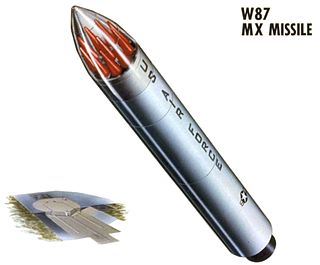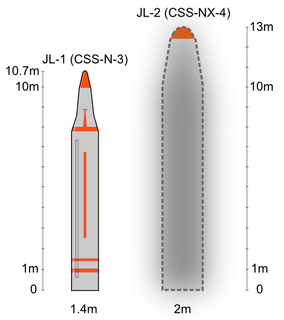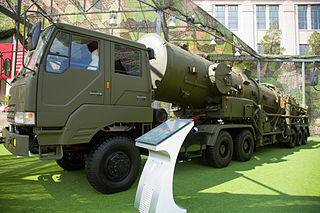
An intercontinental ballistic missile (ICBM) is a ballistic missile with a minimum range of 5,000 kilometres (3,100 mi) primarily designed for nuclear weapons delivery. Conventional, chemical, and biological weapons can also be delivered with varying effectiveness, but have never been deployed on ICBMs. Most modern designs support multiple independently targetable reentry vehicles (MIRVs), allowing a single missile to carry several warheads, each of which can strike a different target. Russia, the United States, China, France, India, the United Kingdom, and North Korea are the only countries known to have operational ICBMs; Israel is believed to possess them as well.

A ballistic missile uses projectile motion to deliver warheads on a target. These weapons are guided only during relatively brief periods—most of the flight is unpowered. Short-range ballistic missiles stay within the Earth's atmosphere, while intercontinental ballistic missiles (ICBMs) are launched on a sub-orbital flight.

In nuclear strategy, a first strike or preemptive strike is a preemptive surprise attack employing overwhelming force. First strike capability is a country's ability to defeat another nuclear power by destroying its arsenal to the point where the attacking country can survive the weakened retaliation while the opposing side is left unable to continue war. The preferred methodology is to attack the opponent's strategic nuclear weapon facilities, command and control sites, and storage depots first. The strategy is called counterforce.

The LGM-30 Minuteman is an American land-based intercontinental ballistic missile (ICBM) in service with the Air Force Global Strike Command. As of 2021, the LGM-30G Minuteman III version is the only land-based ICBM in service in the United States and represents the land leg of the U.S. nuclear triad, along with the Trident submarine-launched ballistic missile (SLBM) and nuclear weapons carried by long-range strategic bombers.

A multiple independently targetable reentry vehicle (MIRV) is an exoatmospheric ballistic missile payload containing several warheads, each capable of being aimed to hit a different target. The concept is almost invariably associated with intercontinental ballistic missiles carrying thermonuclear warheads, even if not strictly being limited to them. By contrast, a unitary warhead is a single warhead on a single missile. An intermediate case is the multiple reentry vehicle (MRV) missile which carries several warheads which are dispersed but not individually aimed. Only the United States, the United Kingdom, France, Russia and China are currently confirmed to have deployed MIRV missile systems. Pakistan and India are developing MIRV missile systems. Israel is suspected to possess or be in the process of developing MIRVs.

The Dongfeng series, typically abbreviated as "DF missiles", are a family of short, medium, intermediate-range and intercontinental ballistic missiles operated by the Chinese People's Liberation Army Rocket Force.

The People's Republic of China has developed and possesses weapons of mass destruction, including chemical and nuclear weapons. The first of China's nuclear weapons tests took place in 1964, and its first hydrogen bomb test occurred in 1967. Tests continued until 1996, when China signed the Comprehensive Test Ban Treaty (CTBT). China has acceded to the Biological and Toxin Weapons Convention (BWC) in 1984 and ratified the Chemical Weapons Convention (CWC) in 1997.

The UGM-133A Trident II, or Trident D5 is a submarine-launched ballistic missile (SLBM), built by Lockheed Martin Space in Sunnyvale, California, and deployed with the American and British navies. It was first deployed in March 1990, and remains in service. The Trident II Strategic Weapons System is an improved SLBM with greater accuracy, payload, and range than the earlier Trident C-4. It is a key element of the U.S. strategic nuclear triad and strengthens U.S. strategic deterrence. The Trident II is considered to be a durable sea-based system capable of engaging many targets. It enhances the U.S. position in strategic arms negotiation with performance and payload flexibility that can accommodate active treaty initiatives. The Trident II's increased payload allows nuclear deterrence to be accomplished with fewer submarines, and its high accuracy—approaching that of land-based missiles—enables it to be used as a first strike weapon.
The Dong Feng 4 or DF-4 is a first-generation two-stage Chinese intercontinental ballistic missile with liquid fuel. It was thought to be deployed in limited numbers in underground silos beginning in the late 1970s and early 1980s. The Dong Feng 4 has a takeoff thrust of 1,224.00 kN, a takeoff weight of 82000 kg, a diameter of 2.25 m, a length of 28.05 m and a fin span of 2.74 m. The range of the Dong Feng 4, which is equipped with a 2,190 kg nuclear warhead with 3.3 Megaton yield, with a nominal range of 5,500 km. This gives it sufficient range to strike targets as far away as Russia, India, and American bases in the Pacific. The missile uses an inertial guidance system, resulting in a large CEP of 1,500 meters. As of 2017, 10–15 launchers are deployed.

The JL-2 is a Chinese second-generation intercontinental-range submarine-launched ballistic missile (SLBM) deployed on the People's Liberation Army Navy's (PLAN) Type 094 submarines. It succeeds the JL-1 SLBM deployed on the Type 092 submarine.

The Dongfeng 5 or DF-5 is a second-generation two stage Chinese intercontinental ballistic missile. It has a length of 32.6 m and a diameter of 3.35 m. It weighs in at 183,000 kilograms and it has an estimated range of 12,000 to 15,000 kilometers. The DF-5 had its first flight in 1971 and was in operational service 10 years later. One of the limitations of the missile is that it takes between 30 and 60 minutes to fuel. The DF-5 is due to be replaced by the solid-fuelled DF-41. Around 2015, the newest variant DF-5B force are believed to have received a MIRV upgrade; according to Business Insider, with DF-5B: "China has the ability to deliver nuclear warheads nearly anywhere on earth ".

The People's Liberation Army Rocket Force, formerly the Second Artillery Corps, is the strategic and tactical missile force of the People's Republic of China. The PLARF is the 4th branch of the People's Liberation Army (PLA) and controls China's arsenal of land-based ballistic missiles—both nuclear and conventional. The armed service branch was established on 1 July 1966 and made its first public appearance on 1 October 1984. The headquarters for operations is located at Qinghe, Beijing. The PLARF is under the direct command of the Chinese Communist Party's Central Military Commission (CMC).

Nuclear weapons delivery is the technology and systems used to place a nuclear weapon at the position of detonation, on or near its target. Several methods have been developed to carry out this task.

The Dong Feng 31 is a third-generation long-range, road-mobile, three stage, solid-fuel rocket intercontinental ballistic missile (ICBM) in the Dongfeng missile series developed by the People's Republic of China. It is designed to carry a single 1-megaton thermonuclear weapon. It is a land-based variant of the submarine-launched JL-2. It is operated by the Second Artillery Corps (SAC) which, in 2009, was estimated to have under 15 DF-31 missiles and under 15 DF-31A missiles in inventory. US Air Force National Air and Space Intelligence Center estimates that as of June 2017, five to ten Mod 1 and over fifteen Mod 2 launchers were operationally deployed.

The Dong-Feng 21 (DF-21; NATO reporting name CSS-5 - Dong-Feng is a two-stage, solid-fuel rocket, single-warhead medium-range ballistic missile in the Dong Feng series developed by China Changfeng Mechanics and Electronics Technology Academy. Development started in the late 1960s and was completed around 1985–86, but it was not deployed until 1991. It was developed from the submarine-launched JL-1 missile, and is China's first solid-fuel land-based missile. The U.S. Department of Defense in 2008 estimated that China had 60-80 missiles and 60 launchers; approximately 10-11 missiles can be built annually.
The Shaheen-II is a Pakistani land-based supersonic surface-to-surface medium-range guided ballistic missile. The Shaheen-II is designed and developed by the NESCOM and the National Defence Complex (NDC) of Pakistan. The Shaheen missile series is named after a falcon that lives in the mountains of Pakistan.
The Dongfeng-41 is a fourth-generation Chinese solid-fuelled road-mobile intercontinental ballistic missile operated by the People's Liberation Army Rocket Force. DF-41 is the fourth and the latest generation of the Dongfeng series strategic missiles developed by China. The missile was officially unveiled at the China National Day military parade on 1 October 2019.
An anti-ship ballistic missile (ASBM) is a military ballistic missile system designed to hit a warship at sea.

The Dong-Feng 11 is a short-range ballistic missile developed by the People's Republic of China.














